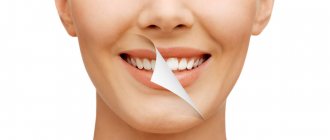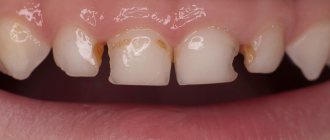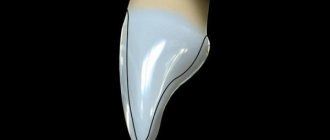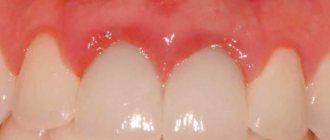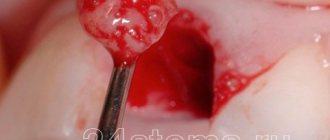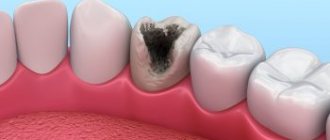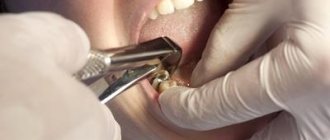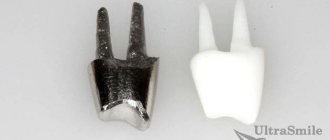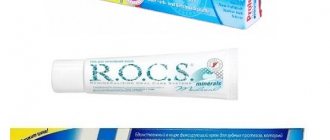Anyone can chip off a piece of their tooth, regardless of whether you take care of your teeth or not. Most often, this is preceded by a mechanical impact on the tooth, less often - gradual destruction of the integrity of the tooth, cracks in the enamel or the development of caries. The most common case is a blow, fall or other injury. Sometimes a tooth can chip when chewing, both in the front and back teeth. Moreover, you don’t have to chew nuts. Quite often, a tooth can break off when trying to bite off a piece of dry salted fish or meat.
It's clear. The way to avoid such a case is to be careful! In the article we will consider points that can increase the likelihood of an unpleasant incident.
Causes of chipped teeth
Several many:
- Weakening of dental tissue due to large consumption of sweets, juices, carbonated drinks and other foods that contain large amounts of sugar and acid;
- Malocclusion;
- Lack of calcium in the body;
- Reduced acidity in the oral cavity;
- Caries;
- Other diseases of the oral cavity;
- General weakening of the immune system;
- Hormonal disorders;
- Smoking;
- Diseases of internal organs.
These reasons, by the way, can also cause loosening of teeth and the development of all kinds of chronic diseases.
Types of chipped dental tissues
Depending on the depth of the damage, damage to the integrity of the tooth can be of several types:
- minimal,
- average,
- severe damage.
Let us now consider these options in more detail.
Minimal damage - a piece of tooth enamel chipped off
The tooth didn't break. Most often, emergency intervention from a specialist is not required. But you should pay attention to this point and consult a dentist. The fact is that if the chip is not healed in time, harmful bacteria can get into the crack and caries will begin to develop. In addition, you may not notice how the enamel will crack along the length of the entire tooth, right down to the root. Within six months, this lack of tooth integrity can lead to serious caries damage.
A piece of tooth has broken off, capturing the hard tissue of the tooth - dentin
It is located under the enamel. In this case, you also cannot feel pain or other unpleasant sensations. You should definitely visit a dental clinic! Even partial damage will cause tooth decay.
A large piece of the tooth broke off, exposing the nerve endings
Quite often in this case the tooth hurts. If not immediately, then it begins to hurt during the first days after the injury. We recommend that you consult a doctor as soon as possible to restore the integrity of the tooth. Otherwise, you can lose the tooth completely and “substitute” the neighboring teeth.
What to do if part of a tooth breaks off?
Visit a dental clinic as soon as possible after your injury. To completely restore damaged tissue and prevent the situation from getting worse, you need to act quickly. If a similar misfortune happens to a person nearby, he may need first aid.
First aid
In case of chipped teeth, specialized medical care is required, but in the first minutes after the injury, you can take a number of measures on your own. Rinse your mouth with warm water (use boiled water) to remove pieces of food and enamel particles. If the gum is damaged and bleeding occurs, apply a sterile bandage to the wound. To reduce pain and swelling, you can cool the tissues surrounding the injured area with ice or a cloth soaked in cold water. If pain causes significant discomfort, take an analgesic (a group of non-steroidal anti-inflammatory drugs).
Therapy at the dental center
To restore the healthy appearance of teeth, dentists use various restoration methods. If there is a minor chip of the enamel, composite materials are used that harden when exposed to light. From the same materials, the doctor creates a dental inlay, which is then attached to the surface of the tooth with glue if the dentin is damaged due to chipping.
Dental inlays are microprostheses, so their creation requires a pre-made impression. But in some clinics it is possible to make a composite inlay in less than a day. Thanks to this, the time spent on treatment is significantly reduced, and the patient stops experiencing pain much faster. This is especially important if there is an injury to the front teeth, and it is also necessary to restore the aesthetic appearance of the dentition.
Veneers are special microprostheses made of various materials (most often ceramics) that help quickly and efficiently correct chipped front teeth on their outer side. Minor chips of the molars are corrected with fillings, and sharp edges of the chip line are smoothed by grinding.
If the pulp is injured, the doctor performs an intervention called depulpation. It helps avoid inflammation and relieves pain. In such a situation, the tooth is restored using a pin. This device reduces the pressure exerted on the injured tooth and prevents its further destruction.
Chipped molars
The method of restoration of molars for chipped teeth is chosen by the dentist individually and depends on the location and degree of injury. Chips on the inside of molars are eliminated by installing fillings, and on the outside, damage is restored using composite materials. It is very convenient to correct damaged lateral teeth by installing metal-ceramic crowns. This material is very durable and can withstand significant loads when chewing food.
Chipped front teeth
If a front tooth is chipped, patients also suffer from psychological discomfort. If the frontal part of the dentition is affected, people may experience difficulty smiling and talking with others, and over time, speech distortions and facial expression disturbances may occur. Therefore, if a tooth is chipped, it is very important to visit the dentist on time.
If the enamel and dentin are damaged when a front tooth is chipped, a filling is installed and the sharp edges of the chip line are polished. When the pulp chamber is injured, the doctor performs depulpation and then fills the tooth (sometimes installing a pin). In some clinical situations, the use of microprostheses (veneers and lumineers) or composite dental inlays is required.
Enamel chip
Enamel is one of the hardest tissues of our body, but despite this, it requires constant and careful care. It is important to monitor its safety and remember the factors that contribute to its destruction. Cracks in enamel can occur due to excess consumption of carbohydrates, excessive consumption of solid foods, poor personal hygiene and bad habits. If after the formation of a chip or crack the dentin is not damaged, people are in no hurry to see a dentist due to the almost complete absence of symptoms. Minimal discomfort in the oral cavity is also a reason to visit a doctor, this way you can avoid many negative consequences and prevent the destruction of dental tissues.
Dentin chip
Dentin is the part of dental tissue located under the enamel that protects the nerve and pulp chamber. In terms of hardness, it is somewhat inferior to enamel. If a tooth is moderately chipped, destruction of dentin is possible, which is why the pathological process penetrates into the pulp chamber. When dentin is damaged during a tooth chip, the sensitivity of the damaged tooth sharply increases (hyperesthesia) when consuming hot, cold, sour, etc.
Chip exposing the pulp
If the pulp chamber is damaged, sharp pain occurs, which is poorly relieved with painkillers. It is recommended to visit a dentist as soon as possible. The doctor removes the pulp, cleans all the canals, removes the nerve, and then begins to restore the injured tooth. We invite you to visit our dentistry! We provide dental services near the Krasnye Vorota, Baumanskaya, Tretyakovskaya metro stations, as well as Novokuznetsk.
Tooth restoration
No matter the scale of the tooth chipping, go to the dentist! There are no traditional methods or glue that can glue part of a tooth together. Only an experienced doctor can choose a treatment tactic.
The following options exist:
Small chips may not even need to be filled. Modern dentistry provides the most gentle way to restore tooth integrity.
For moderate damage, you will need to use a drill and install a filling, and sometimes build up a tooth.
In case of severe damage: installation of veneers, pins, crowns, inlays.
In particularly difficult cases, if the chip goes directly into the gum, the tooth may be removed.
Restorative methods in dentistry
The method of restoration depends simultaneously on several factors: the degree of damage, the results of diagnostic studies, general health, medical history and financial capabilities of the patient. The therapeutic regimen is developed on an individual basis. What to do if a front tooth is chipped and why the back teeth are chipped should only be determined by a doctor; self-diagnosis is ineffective.
Remineralization
Remineralization therapy is the simplest recovery option for minor chips. The technique is used for microcracks and other small defects, as well as for preventive purposes to prevent such problems. A special solution with nutrients is applied to the surface, and as a result, the protective properties of the enamel are restored.
Fluoridation
Damaged and healthy teeth are covered with medicinal solutions, gels or varnishes with a large amount of fluoride. Treatment is carried out in stages. This is one of the effective ways to completely restore a chipped front tooth. This method is only beneficial for minor injuries.
Building up
Indicated for moderate injuries. A paste-like mass is applied to the surface in layers, each layer is fixed. The doctor must carefully select materials of the desired shade and texture so that the restored areas remain invisible and do not stand out from the rest.
This method is highly effective and attractively priced. The first thought that arises in most patients when asked what to do if a back tooth is chipped (chipped front teeth are rarely eliminated in this way) is to build up the missing fragment. The technique is in great demand.
Filling and microprosthetics
They are indicated for extensive damage to bone tissue and internal sensitive layers. The doctor carefully examines the results of diagnostic studies (including panoramic and spot images), listens to the patient’s complaints and advises which method is best to use. Restoration is possible using conventional fillings, inlays, veneers, and lumineers. What to do if a back tooth breaks off (the reasons do not matter) and is completely lost? In such a situation, prosthetics using implants or installation of artificial crowns is performed.
The amount that the patient sees in the final settlement after the intervention may be unpleasantly surprising. Before you ignore a small crack in the enamel and neglect a visit to the dentist, it is better to think about possible upcoming expenses.
Precautionary measures
Tips for avoiding chipped teeth follow general oral health tips:
- Visit your dentist regularly for dental examinations and professional teeth cleanings;
- taking vitamin and mineral complexes;
- brush your teeth morning and evening;
- limit the consumption of sweets, carbonated water, juices;
- do not smoke and limit alcohol consumption;
- treat teeth in the early stages of disease development;
- Treat diseases of organs and systems in a timely manner.
It is important to understand that an untreated tooth can lead to complications - from simple to very serious. Most often we are talking about caries, pulpitis, periodontitis. Doctors will confirm to you that a chipped tooth and infection can cause the development of chronic diseases of the heart, kidneys, stomach, liver, and nervous system.
INNOVASTOM offers an integrated approach to the treatment and prevention of dental and gum diseases in Smolensk. We are confident that we will help you maintain the health of your teeth!
Example 1: Root caries
Caries, or a chipped tooth wall, extends deep under the gum.
Root caries is a direct indication for tooth extraction.
It is impossible to place a high-quality filling under the gum (there is always an overhanging edge, under which plaque and microbes accumulate). It will also not be possible to restore such a tooth with an artificial crown, because saliva and microbes will constantly get under the crown in the defect area; decementation of the crown and further destruction of root tissue will periodically occur.
That is, all attempts to “save” a tooth diagnosed with “root caries” can lead to the following:
accumulation of plaque and microbes under the installed filling or crown,
↓
the appearance of caries on the contact surface of an adjacent tooth,
↓
inflammation of the gum next to the tooth,
↓
formation of a deep periodontal pocket between the tooth and gum,
↓
gradual destruction of bone tissue around the tooth
↓
problems with implantation in this area.
Thus, treatment of teeth with tissue destruction below the gum level is pointless and can only be carried out as a temporary measure in order to delay the inevitable removal.
